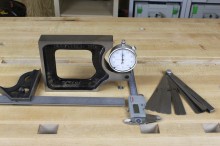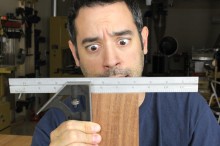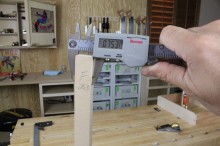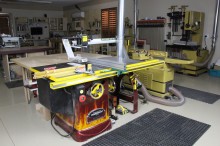How Much Error is Too Much?
Article - April 18, 2013
 As woodworkers, we have a bunch of jobs aside from the woodworking itself that allow us to run a safe and efficient shop. One of the more frustrating is the “machinist” work. Not only do we need to know how to operate tools, we also need to know how to calibrate, repair, and sometimes even modify them. As a result, we tend to take our cues from other industries where accuracy is paramount, such as metal work. In many wood shops, you can find at minimum, calipers, feeler gauges, dial indicators, and numerous other doo-dads that help us measure error in our work and our machines.
As woodworkers, we have a bunch of jobs aside from the woodworking itself that allow us to run a safe and efficient shop. One of the more frustrating is the “machinist” work. Not only do we need to know how to operate tools, we also need to know how to calibrate, repair, and sometimes even modify them. As a result, we tend to take our cues from other industries where accuracy is paramount, such as metal work. In many wood shops, you can find at minimum, calipers, feeler gauges, dial indicators, and numerous other doo-dads that help us measure error in our work and our machines.
 This level of accuracy can be enlightening and stifling at the same time. As we know, wood moves. So there’s a point where dialing things in to the Nth degree provides quickly diminishing returns. But where should we draw the line? Sadly, there’s no easy answer and even if there is an answer, it is likely different for everyone. Depending on the tool, the material, the project and the person, the numbers can and will be different.
This level of accuracy can be enlightening and stifling at the same time. As we know, wood moves. So there’s a point where dialing things in to the Nth degree provides quickly diminishing returns. But where should we draw the line? Sadly, there’s no easy answer and even if there is an answer, it is likely different for everyone. Depending on the tool, the material, the project and the person, the numbers can and will be different.
This article was inspired by a long-time friend of the show, Adam, who expressed his discontent with the level of accuracy he was able to measure with his cross-cut sled. His ability to measure error seems to have exceeded his ability to adjust for it. A problem I have had myself recently. Frankly, this is probably more commmon than any of us are willing to admit.
 While making his sled, Adam used the well-know 5-cut method which I demonstrated in my Cross-Cut Sled Video. By making multiple subsequent cuts on the same piece of wood, the method magnifies the error by a multiple of four. This is powerful stuff when you’re looking to dial in your fence setting and if you have the ability to make teeny tiny adjustments, it can be quite effective. But what happens when you can’t seem to get the fence any more accurate. Perhaps every adjustment you make seems to just make the error worse. At what point is it good enough?
While making his sled, Adam used the well-know 5-cut method which I demonstrated in my Cross-Cut Sled Video. By making multiple subsequent cuts on the same piece of wood, the method magnifies the error by a multiple of four. This is powerful stuff when you’re looking to dial in your fence setting and if you have the ability to make teeny tiny adjustments, it can be quite effective. But what happens when you can’t seem to get the fence any more accurate. Perhaps every adjustment you make seems to just make the error worse. At what point is it good enough?
For me, the acceptable amount of error is right at the cusp of where I notice it. While assembling a project, if I have an 18″ wide panel that is off square by about 1/64″, would I notice? Would I even be able to see it with the squares I have access to? I doubt it. And I’m guessing most of you wouldn’t be able to spot the error either. Of course not every project involves wide panels, so for everything else we process with a cross-cut sled, such as joinery, the error would be even less impactful.
All that said, if I can further reduce the level of error without driving myself crazy, I’ll give it a shot. But if I think trying to improve on it will simply make the situation worse, I simply stop while I’m ahead and proceed with the acid test: a project. If you don’t notice the error during actual project construction, then for all practical purposes the error does not exist.
A Good Lesson
 Here’s a story that might help put things in perspective. When I received my current table saw (the PM2000 with the flames), I started to stress about the flatness of the top. I can’t remember how much of a dip it had but it was more than most of us would consider acceptable. I’m picky, but not THAT picky. So I asked for a new top and the manufacturer agreed that it was a little too much error. Unfortunately, the second top had the same problem. I lost a few weeks of table saw time as a result of this fussing around and decided I had enough. I needed to get back to work. I bolted the top down, calibrated the saw as well as I could and started on the next project. It was bugging the heck out of me that I was going to “live with” this error but I pushed forward. Over 6 years later (or something like that), I have yet to notice ANY negative impact in my work. The final fit and finish of my projects is as good as I expect it to be.
Here’s a story that might help put things in perspective. When I received my current table saw (the PM2000 with the flames), I started to stress about the flatness of the top. I can’t remember how much of a dip it had but it was more than most of us would consider acceptable. I’m picky, but not THAT picky. So I asked for a new top and the manufacturer agreed that it was a little too much error. Unfortunately, the second top had the same problem. I lost a few weeks of table saw time as a result of this fussing around and decided I had enough. I needed to get back to work. I bolted the top down, calibrated the saw as well as I could and started on the next project. It was bugging the heck out of me that I was going to “live with” this error but I pushed forward. Over 6 years later (or something like that), I have yet to notice ANY negative impact in my work. The final fit and finish of my projects is as good as I expect it to be.
So the moral to the story is, a problem isn’t a problem unless it’s a problem! Whenever I calibrate my tools now, I try to get as close to the ideal scenario as possible. Once again, I do this without driving myself nuts. I can’t afford to spend an entire day tuning up a jointer. Once I feel I have it as dialed in as I can reasonably get, I begin working. If at some point in the future I find that the quality of my work is diminishing thanks to a particular level of calibration error, then I know that for me, in that particular situation, the error was too great and it needs to be adjusted. If I never notice anything and my work meets my personal standards, then there really is no problem at all and the tool is accurate enough.



